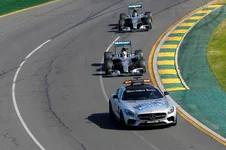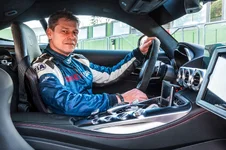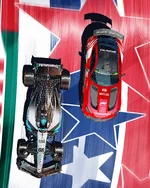- 500 Grand Prix: From debut at Magny-Cours in 1996 to anniversary in Austin in 2025
- Record at Fuji: 19 consecutive laps at the 2007 Japanese Grand Prix
- High performance for safety: Mercedes-AMG GT Black Series in use since 2022
The F1® Grand Prix of the United States in Austin (Texas) marks a special milestone in terms of safety: for the 500th time, a vehicle bearing the star emblem will be on duty as the Official FIA F1® Safety Car in the premier class of motorsport. The very first engagement dates back to 30 June 1996 in Magny-Cours (France), at that time with a Mercedes-Benz C 36 AMG. Since then, Mercedes-Benz and Mercedes-AMG have been represented in Formula 1® and ensure the highest level of safety on race tracks worldwide. 13 different vehicle models have been used to date. Since 2022, the uncompromising Mercedes-AMG GT Black Series has taken on this task. Bernd Mayländer, former racing driver, AMG brand ambassador and a prominent figure in safety for 25 years, has been at the wheel of the Official FIA F1® Safety Car since 2000. Mercedes-AMG brings its many years of experience not only to the Official FIA F1® Safety Car, but also to the Official FIA F1® Medical Car, which is also celebrating its 500th appearance in Austin. Both vehicles are also represented in F2, F3 and other junior and support racing series. For its anniversary appearance in Austin, the Official FIA F1® Safety Car will feature a special design with the distinctive number 500.
Mercedes-Benz and Mercedes-AMG vehicles ensure safety in Formula 1®
For 29 years, Mercedes-Benz and Mercedes-AMG vehicles have been serving as Safety Cars in Formula 1®. As soon as there is imminent danger – for example, due to accidents, debris on the track or extreme weather conditions – race control sends the Official FIA F1® Safety Car into action. There, it leads the field, slows down lap times and neutralises the race. The speed is determined by race control depending on the situation. A particular challenge for Bernd Mayländer and the technical team is striking the right pace to ensure safety on track while keeping the field of F1® cars in optimal running conditions. For the drivers, its deployment primarily means safety. At the same time, it often has a strategic component for the teams: pit stops under safety car conditions take significantly less time and can therefore be decisive for the race.
Mercedes-AMG provides a total of three Official FIA F1® Safety Cars. Two of these vehicles are on standby at every race weekend. As soon as the Official FIA F1® Safety Car is on the track, the light and signal systems are activated. Since 2022, these are no longer mounted as bars on the roof of the vehicle, but are fully integrated into the vehicle – for optimum aerodynamic functionality. A total of 21 LED modules ensure visibility: six in the windscreen, thirteen in the rear wing and two on the rear number plate. When in use, fourteen light up continuously in orange, while seven in the centre of the rear wing flash in the same colour. Together with the digital information provided on site and the instructions from the race engineers, this is a clear signal to the drivers to line up behind the Official FIA F1® Safety Car. When the signals turn green, the vehicle may be overtaken.
The most laps behind the Official FIA F1® Safety Car in a race were driven in São Paulo (Brazil) in 2016. A total of 33 laps were completed in four separate deployments – seven in the first, seven in the second, twelve in the third and another seven in the fourth. The longest safety car phase, with 19 laps in one go, was in 2007 in Fuji (Japan) with the CLK 63 AMG. The Official FIA F1® Safety Car had to take to the track most frequently in 2011 at the Canadian Grand Prix. Bernd Mayländer had to take to the track in the SLS AMG a total of five times, completing four, four, fifteen, four and three laps respectively.
Continuity and excellence: Since 25 years, Bernd Mayländer has been driving the Official FIA F1® Safety Car
The 51-year-old Swabian has been driving the Official FIA F1® Safety Car since 2000 and has thus been a constant presence in the service of the FIA for 25 years. He is supported in Formula 1® alternately by co-drivers Richard Darker and Ignazio Sanzone. Behind the safety car duo is a well-coordinated team of FIA employees and three Mercedes-AMG employees – a coordinator, a mechanic and an electrician – who coordinate and ensure the smooth operation of the Official FIA F1® Safety Car. They take care of maintenance, logistics and the back-up vehicles. Before each race weekend, the Official FIA F1® Safety Car must complete three to five high-speed laps on Thursday for one hour and on each day with official sessions in the morning to test all systems.
The 500th deployment of the Official FIA F1® Safety Car is not only an impressive record, but also a testament to decades of experience, technical excellence and trust in Mercedes-AMG. It illustrates the development of safety car technology over almost three decades and underlines its indispensable role at the pinnacle of world motorsport.
Current Official FIA F1® Safety Car: Mercedes-AMG GT Black Series
Since 2022, the Mercedes-AMG GT Black Series has been used as the Official FIA F1® Safety Car in Formula 1®. This uncompromising vehicle was developed with a consistent focus on the racetrack, continuing the tradition of the Black Series models that have been part of the Mercedes-AMG portfolio since 2006.
The AMG GT Black Series is the most powerful Mercedes-AMG with a V8 series engine to date. Its 4.0-litre V8 biturbo with flat crankshaft and dry sump lubrication delivers 537 kW (730 hp) and accelerates the vehicle from 0 to 100 km/h in just 3.2 seconds. Active aerodynamics ensure maximum driving stability. The design and numerous technical details are derived from the current Mercedes-AMG racing cars – including the significantly larger cooling air intake, which has been adopted from the Mercedes-AMG GT3.
The Mercedes-AMG GT Black Series as the Official FIA F1® Safety Car version has been modified in many details compared to the production vehicle in order to meet the requirements of a Grand Prix weekend. In addition to the integrated LED lighting system, these include a siren in the front right wheel arch, FIA-compliant communication and radio technology for direct connection to race control, additional screens in the cockpit, a digital interior mirror for the co-driver and a camera in the rear wing. The equipment is supplemented by FIA standard telemetry, a timing system and the onboard camera system including the associated antenna – similar to the F1® racing cars. Since 2023, the vehicle has been fuelled with PETRONAS Primax Pro-Race M2, a 100-octane fuel consisting of 40% sustainable components (10% ethanol, 30% eFuel).
Mercedes-Benz and Mercedes-AMG Official FIA F1® Safety Cars at a glance
| 1996: Mercedes-Benz C 36 AMG (W202) |
| 1997 – 1999: Mercedes-Benz CLK 55 AMG (C208) |
| 2000: Mercedes-Benz CL 55 AMG (C215) |
| 2001 – 2002: Mercedes-Benz SL 55 AMG (R230) |
| 2003: Mercedes-Benz CLK 55 AMG (C209) |
| 2004 – 2005: Mercedes-Benz SLK 55 AMG (R171) |
| 2006 – 2007: Mercedes-Benz CLK 63 AMG (C209) |
| 2008 – 2009: Mercedes-Benz SL 63 AMG (R230) |
| 2010 – 2012: Mercedes-Benz SLS AMG (C197) |
| 2012 (since Grand Prix of Germany) – 2014: Mercedes-Benz SLS AMG GT (C197) |
| 2015 – 2017: Mercedes-AMG GT S (C190) |
| 2018 – 2021: Mercedes-AMG GT R (C190) |
| 2022 – today: Mercedes-AMG GT Black Series (C190) |
Mercedes-Benz/Mercedes-AMG Official FIA F1® Medical Cars at a glance
| 1996: Mercedes-Benz C 36 AMG (W202) |
| 1997: Mercedes-Benz C 36 AMG (W202); Mercedes-Benz E 60 AMG (W210) |
| 1998 – 2000: Mercedes-Benz C 55 AMG T-Modell (S202) |
| 2001 – 2003: Mercedes-Benz C 32 AMG T-Modell (S203) |
| 2004 – 2007: Mercedes-Benz C 55 AMG T-Modell (S203) |
| 2008 – 2014: Mercedes-Benz C 63 AMG T-Modell (S204) |
| 2015 – 2021: Mercedes-AMG C 63 S T-Modell (S205) |
| 2022 – today: Mercedes-AMG GT 63 S 4MATIC+ (X290) |
“Not only Formula 1, but also the Safety Cars have continuously evolved since the first vehicle bearing the star emblem was deployed in 1996. We are proud of this long-standing collaboration and of the trust placed in us by the FIA to actively contribute to safety in the pinnacle of motorsport with our high-performance products. It underlines our ambition to unite precision and performance at the highest level. We are particularly pleased to carry this responsibility from Affalterbach and – even under extreme conditions – to remain a dependable partner. For many years, Bernd Mayländer has been an equally experienced and trusted colleague from within our ranks.”
Christoph Sagemüller, Head of Mercedes-AMG Motorsport
“I’ve had the honour of driving many fascinating Mercedes-Benz and Mercedes-AMG cars in Formula 1. I’m proud of that and at the same time deeply grateful. Over the years, I’ve experienced countless unforgettable moments. One of the most remarkable was the Grand Prix in Fuji in 2007. I was out on track for 19 laps, already keeping a close eye on the fuel gauge. Then the rain eased, the race was released, and I came into the pits to switch to the second car – only to be sent straight back out again after an accident. That race will always stay with me.”
Bernd Mayländer, Official FIA F1® Safety Car Driver & AMG Brand Ambassador
Continue reading...



















